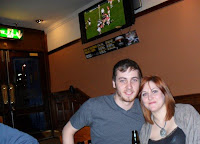In many ways, my magazine follows the typical conventions of music magazines such as Q. The front cover of the magazine is very typical of this magazine. I used a very large, bold Masthead which would attract attention. I then used a editorial style mid shot photograph of a girl, and superimposed it onto the masthead as this is conventional, and suggests the artist is important. The photograph is of a convetionally attractive girl, making eye contact with the camera and confident body language - which is conventional. For the main coverline about the photograph, i used really large bold font which splashed across the page with a topic sentence underneath. The overall layout of the front cover is similar to those of Q or Rolling Stone. I desaturated the photograph so it is mostly black and white however i left the orange lips of the model bright orange. I used this as the centre of my housestyle and used splashes of orange in text etc. I used typical music magazine language for the sell lines, strapline and plugs on the front cover.
I used a consistant housestyle throughout the magazines - the main colours being black, white. orange and purple. My feature article is quite conventional, in an interview style article with a brief introduction. I used one of the pages as a photograph, like a poster. The title for the article is in bold and attention grabbing font, with appropriate language used throughout the article. The name of my magazine - CLASH - is conventional as musically sounding works are often used.
My contents page is moreso in the style of NME magazine, the layout is busier than the simpler styles I chose for the cover and article. I done this because, in my research, I looked at all aspects of many music magazines and preferred the busy contents pages of NME, and so I suppose in this way my magazine is not conventional - it mixes two types of style.
The main way in which my magazine challenges conventions of music magazines is the target audience - I aimed to make a music magazine which included more aspects of fashion and female artists that female readers would be interested in. I think this worked, as I used more fashion style photography to attract these readers, and wrote my feature article on a female musician. I do think that men would be able to be attracted to this magazine also.
















